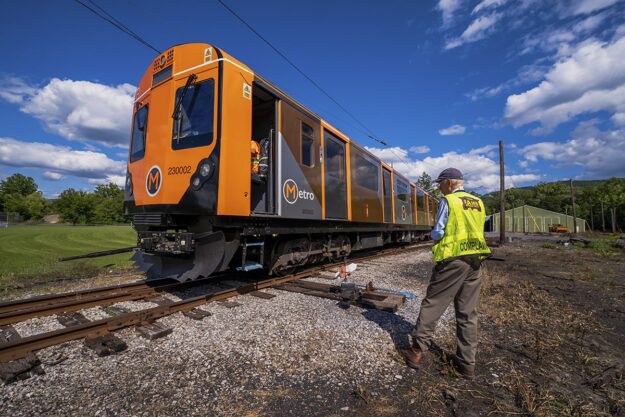Widgetized Section
Go to Admin » Appearance » Widgets » and move Gabfire Widget: Social into that MastheadOverlay zone
Vail Mayor Langmaid calls for train to Vail, less rhetoric on Mexico, immigration

Rail expert Henry Posner III, who has reached out to Vail Mayor Kim Langmaid, watches a new battery-powered passenger train (Carnegie Mellon University photo).
Outgoing Vail Mayor Kim Langmaid, in a phone interview during the Mountain Towns 2030 Climate Solutions Summit in Vail last week, said one of the best ways to tackle planet-warming carbon emissions from the transportation sector would be a commuter and tourist train the length of Eagle County from Dotsero to Vail, with a connection to the Eagle County Regional Airport near Gypsum.
Langmaid, who is term-limited and wraps up her eight years on Vail Town Council and two years as mayor in November, also touched on how critical Vail’s relationship with Mexico is and how divisive anti-Mexico and anti-immigrant political rhetoric has become in the United States.
Finally, as the Vail native contemplates her legacy on council, Langmaid struck a proudly defiant tone in terms of just how much workforce and community housing the council has brought online over the past eight years, despite a heated legal battle with the Vail Resorts ski company.
Langmaid founded the Walking Mountains Science Center in the tiny former mining town of Red Cliff in the 1990s when freight trains were still rumbling over Battle Mountain Pass and through town on the now-dormant Tennessee Pass Line, which connects with Union Pacific’s active Central Corridor (Moffat Tunnel Subdivision) at Dotsero in western Eagle County.
Those long, heavy freight trains, pulled by multiple diesel-powered locomotives to navigate steep climbs, passed near Vail where Gore Creek meets the Eagle River at Dowd Junction, but there are no tracks in the Gore Creek Valley where Vail hosts a million and a half skier days a year. Langmaid thinks new battery-powered trains should use existing tracks and then head east toward Vail on new tracks that would quietly traverse the Interstate 70 right of way.

“I’ve always thought that bringing back the trains specifically for commuters and to support tourism would be a great move for us,” Langmaid said. “All of the communities involved in the Climate Action Collaborative want to reduce the number of vehicles on the road. The train could be a great solution. We hear people who say they don’t want a high-impact train, but a low-impact, clean-energy, commuter and tourism-oriented train and rail line could really be a game-changer for this valley because the impacts of I-70 are becoming more and more, even with just rush-hour traffic here in these small mountain communities getting worse with every year.
“So it may not feel like it’s an urgent need right now, while housing is probably one of the most urgent needs, but we need to start laying the groundwork so that we’re ready for when that opportunity may come. And I don’t think it’s something that Eagle County and our local governments can accomplish on our own. We’re going to need financial support from other parties, the state, the rail line itself, the owners there, to make this happen,” Langmaid added.
The mostly dormant 220-mile Tennessee Pass Line from Dotsero to Pueblo travels along the Eagle and Arkansas rivers. It was part of an Eagle County lawsuit to stop a Utah oil trains proposal, and has come up in discussions over the renewal of UP’s long-term lease to use the state-owned Moffat Tunnel at Winter Park.
While getting workers to the up-valley resorts of Beaver Creek and Vail from down-valley areas where housing is more attainable would be a top priority for Langmaid, she said the train would also be a huge tourism draw to avoid the constant gridlock of I-70 between Vail and the Denver International Airport.
“We have such a beautiful area here and should revitalize the rail that can bring people from Dotsero to Vail or up to Leadville to experience this place in a different way,” Langmaid said. “I mean, riding on a train is so much different than driving a car, obviously. You can really enjoy the place and take it all in. And after experiencing trains on our sister city visits to Switzerland [St. Mortiz] and to Japan [Yamanouchi], you realize that we have such an opportunity here, and it’s just kind of strange that we don’t take more action to make it happen through our mountain communities.”
Ski resorts in both Japan and Europe are famously accessible by high-speed trains that avoid the hours-long highway quagmire seen in Colorado as a result of weekend skier traffic on snow-choked Vail Pass and through the Eisenhower Tunnel.
Transportation by air and car to Vail accounts for a huge share of its greenhouse gas emissions. Residential and commercial buildings account for 47.5% of all Eagle County emissions, with the transportation sector second at 42.2% of emissions. While new building codes are in the works, transportation currently is at the mercy of battery technology and overall electrification of the sector. And the Eagle Valley Regional Transportation Authority is plagued by a lack of bus drivers (tied to a lack of housing) and equipment. Trains require far fewer operators.
“We need to get on the bandwagon here and start getting involved in some of these [statewide passenger rail] conversations and initiatives and gather more information and put it into our transportation plans,” Langmaid said. “And the Town of Vail is working now on a transportation and mobility plan that’ll run us into 2040 or something like that. So if people are interested in this, they ought to tap into that plan and give more input.”
Vail in the past also had a sister city relationship with San Miguel de Allende, Mexico, although San Miguel last year signed a sister-city relationship with Vail rival Aspen.
But since its founding in the 1960s, Vail has been both a tourism destination for Mexican skiers and a second homeowner market for Mexican nationals. Eagle County’s economy also relies heavily on Latino labor to operate. Like her mayoral predecessor, bar owner Dave Chapin, Langmaid is alarmed by anti-Mexico rhetoric by the Republican presidential frontrunner and GOP threats of U.S. military intervention in Mexico.
“I feel like that kind of rhetoric and dialogue is completely divisive and it disregards the history of the American West. There are long-time Hispanic families here that came here before the U.S. was even created, before we had our contemporary United States, and they were part of creating these communities. When I was a kid, most of the families in Minturn and Red Cliff, we went to school together. So it’s always been 50-50, Hispanic families and White families, if you will. And so it’s just part of our culture, and it always has been. It’s just completely divisive and the wrong direction for us to be going.”
Langmaid urges better cooperation with Mexico on security issues and comprehensive immigration reform from Congress, which has been gridlocked on the issue for decades.
“Mexico, Mexican families have always been a part of the Town of Vail and are important to its future, and so I think we’d need to work more closely with our elected officials at the national level to make sure that Mexicans have safe access to our mountain communities,” Langmaid said.
Finally, on the topic of affordable and attainable workforce and community housing, Langmaid called out Broomfield-based Vail Resorts in the wake of lengthy and costly condemnation battle with the town that earlier this month seemed to come to a conclusion with a 5-2 council decision but could still be appealed by the ski company.
“I am totally proud of all the things we’ve done,” Langmaid said of the Town of Vail’s push for more housing. “Our current council will be known as the council that has created more housing for our community than any other in the history of Vail. At the same time, we’re being accused by Vail Resorts of doing nothing and being NIMBY [Not in My Backyard].”
Vail Resorts did not respond directly to Langmaid’s comment but instead referred to a previous statement regarding the condemnation battle: “We appreciate the work of the court, and the panel of experts, in determining the value of the land in Vail Town Council’s condemnation case. As we have said previously, we do not believe the town’s plan to pay us money to condemn this land, and prevent the affordable housing project planned on it, is good for our community.”
Editor’s note: This story has been clarified to report that Vail no longer has a sister city relationship with San Miguel de Allende, Mexico, and that San Miguel last year signed a sister-city relationship with Vail rival Aspen.
David O. Williams
Latest posts by David O. Williams (see all)
- In governor’s primary race, Bennet, Weiser sparring over who is tougher on Trump - July 15, 2025
- The O. Zone: Battle for public lands just now heating up, much like our atmosphere - July 14, 2025
- Immigrant rights groups push Colorado AG Weiser for probes into violations of ICE collaboration law - July 11, 2025



John Ives
October 28, 2023 at 10:24 am
Nice article. I appreciate the deep dive into Mayor Langmaid’s thought process regarding potential train service in the Vail Valley.
I do find her thoughts and efforts misplaced. Generally speaking, we do not have a traffic problem down valley. Morning and afternoon commute traffic tends to be dominated by tradespeople and goods being moved up and down valley. There is certainly a mix of solo commuters and the trades. Understanding this mix would be critical to understand the market for train service.
One would also have to keep in mind that a portion of the Valley just approved a significant increase in sales taxes to fund an expansion of bus service. The decision by the citizens of Gypsum to NOT subject themselves to the tax increase for the increased service has to be kept in mind. If Gypsum citizens do not see the need for increased bus service, how supportive of an expensive rail service tax does she expect?
In my opinion, we would receive more bang for the buck with burrowing a I-70 tunnel under the Eagle’s Nest Wilderness area to allow a quick, safer drive between Vail and Silverthorne.
A distant second option would be the creation of passenger service between Gypsum and at least Glenwood Springs–maybe farther west to Rifle. Regular service between Gypsum and GWS would give lower Valley residents more predictable transportation to retail and healthcare options in Glenwood. It would also be a relief valve when I-70 is closed in the Canyon.
I guess a theme is to focus on the choke points in the Valley–Vail Pass and Glenwood Canyon.